|
|
Meddler

|
|
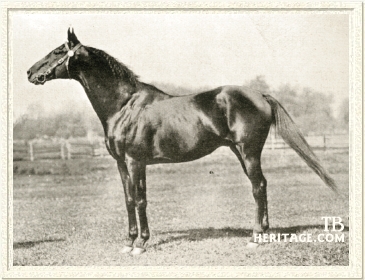 |
|
|
The life of Meddler revolved around the deaths of a succession of his owners. The premature death of his breeder curtailed his promising racing career. But the series of events which followed, including the deaths of two more owners, actually proved remarkably beneficial to the horse during his second career as a stallion, affording Meddler opportunities at stud he might not have had under other circumstances.
Meddler was an English-bred, foaled in 1890. He was bred by George Alexander Baird, a wealthy, eccentric, and quick-tempered young Scotsman who raced under the name "Mr. Abington." Baird was one of the most colorful characters associated with the British turf in the nineteenth century. He was recognized as one of the best amateur riders in England, and had a reputation as a hard drinker, heavy gambler, and notorious womanizer. One of his paramours was actress Lillie Langtry, with whom he had a long and tumultuous affair. Baird's relationships with women were often stormy because of his volatile temper. Baird was said to treat his horses better than his women. He campaigned Derby winner Merry Hampton and One Thousand Guineas and Oaks winner Busybody. The latter became the dam of Meddler.
Busybody was as royally bred as any mare could be. She was bred by Lord Falmouth at his Mereworth Castle Stud. Her sire, Petrarch, was a top class winner every year he raced, accounting for the Middle Park Plate at two, the Two Thousand Guineas, Prince of Wales's Stakes, and St. Leger at three, the Ascot Gold Cup at four, and the Rous Memorial Stakes at Ascot at five. At stud, he brought not only his solid racing credentials, but a resplendent pedigree. Petrarch was sired by St. Leger winner Lord Clifden and was out of Laura, a daughter of Derby winner Orlando. His second dam, Torment, was sired by Ascot Gold Cup winner Alarm, and was also dam of Oaks victress Tormentor. Petrarch, first as a stallion at the Hampton Court stud, and later at Lanwades Stud, Kennett, proved quite successful. In addition to Busybody, he got Miss Jummy, a winner of the One Thousand Guineas and Oaks; The Bard, a good winner in England of twentytwo races at ages two and three and a good sire in France; and Throstle, a winner of the St. Leger.
The female family of Busybody was just as illustrious as her sire's, for her dam, Spinaway, was victorious in the One Thousand Guineas and Oaks for Lord Falmouth, and was a half sister to One Thousand Guineas and Oaks winner Wheel of Fortune. Both Spinaway and Wheel of Fortune were out of Lord Falmouth's foundation mare Queen Bertha, herself a winner of the Oaks.
|
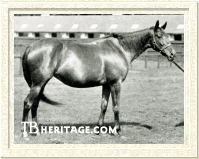
Busybody
| |
It was rare for a filly with a pedigree as impeccable as Busybody's to come up for sale on the open market. Yet Busybody did, due to the decision of Lord Falmouth to retire from racing in the early 1880s. He held a dispersal sale of his Mereworth Castle Stud bloodstock in the spring of 1884. Among the horses sold were Harvester, who would dead-heat for victory in that year's Derby with St. Gatien, and Busybody, winner of the Middle Park Plate the previous season. George Alexander Baird purchased Busybody, and in so doing, acquired another classic performer, for the filly went on to capture the One Thousand Guineas and Oaks.
|
In 1889, Baird sent Busybody to be covered by St. Gatien. In contrast to the classically-bred Busybody, St. Gatien's familial connections were positively plebeian. He was sired by The Rover or Rotherhill, and was out of St. Editha, a daughter of the unimportant sire Kingley Vale. St. Editha could not win and produced nothing of any racing class either before or after St. Gatien. She did produce one other foal of some historical significance, that being the Bend Or filly Sylvabelle, destined to become the second dam of leading American sire Broomstick. Both of the horses said to be the sire of St. Gatien were of little consequence. The Rover was unplaced in all four of his starts at two, the only year he raced, and was only used at stud due to the fact he was a son of Derby winner Blair Athol. Rotherhill started only once at two, was unplaced, and retired to stud. He was a full brother to Petrarch, which meant that if he was indeed the sire of St. Gatien, then St. Gatien's son Meddler carried a 2x2 inbreeding to the full brothers Petrarch and Rotherhill.
Pedigree aside, St. Gatien was an outstanding racetrack performer, for in addition to his dead-heat victory in the Derby, his career included scores in the Ascot Gold Vase, Alexandra Plate, Rous Memorial Stakes, Ascot Gold Cup, and three runnings of the Jockey Club Cup. St. Gatien was not as successful at stud. During his career, he stood in England, Germany, and the United States. Meddler was his best.
Meddler on the Turf
Meddler made his first start on June 22, 1892 at Sandown Park in the British Dominion Two-Year-Old Stakes. With George Barrett in the saddle, Meddler won by three lengths. At Newmarket on July 14th, Meddler was ridden to victory by Mornington Cannon in the Chesterfield Stakes. Meddler was not seen out again until October 27, for the Dewhurst Plate. Here he met the Duke of Portland's St. Simon colt Raeburn. Meddler had a bit harder assignment this time, for he defeated Raeburn by only half a length. Put away for the season, Meddler was considered one of the top prospects for the next season's classics, the other being Isinglass, an Isonomy colt also undefeated in three starts.
A meeting of these two colts was never to take place because of events which transpired over the winter. Baird, in addition to his other passions, was an aficionado of boxing. Early in 1893, he offered to put up the prize money for a proposed match between "Gentleman Jim" Corbett and John L. Sullivan. He traveled to America and the city of New Orleans to try and arrange the match. He was accompanied by a friend, a fighter named Jem Hall. Before negotiations for the proposed match ever began, Baird accompanied Jem Hall to the boxing arena, where the latter fought and was beaten by Bob Fitzsimmons. Baird dulled the disappointment of his friend's pugilistic loss by going on a drinking binge around New Orleans. A chill caught on this night of carousing led to his premature death at the age of 31. Baird left his money in trust to his mother. His horses, including Meddler, were slated to be sold.
Baird's sudden death changed the course of events for his promising colt Meddler. By the rules of racing then in force, Baird's demise rendered void all of Meddler's stakes engagements --- including his engagements in the classic races. In his absence, Isinglass swept the Guineas, Derby, and St. Leger to land the Triple Crown. Meddler, on the other hand, never set foot on a racecourse again.
Meddler in the Stud
Baird's horses came up for sale on June 26, 1893. William H. Forbes of Readville, Massachusetts purchased Meddler for $76,000. Meddler was shipped across the Atlantic to serve stud at Forbes' Neponset Stud near Readville. The colt PREVIOUS, out of the Mortemer mare Sunnyside, came from Meddler's first crop. Previous gained fame by defeating Hamburg in the Great American Stakes and finishing ahead of that same rival in the Belmont Stakes of 1898 won by Bowling Brook. Previous enjoyed a moderately successful stud career, his best being Effendi, winner of the 1909 Preakness Stakes.
Meddler stood at Neponset until 1897, when Forbes died. The stud was dispersed and Meddler was purchased for $49,000 by William Collins Whitney. Meddler was installed at Whitney's La Belle Stud near Lexington, Kentucky. From his 1898 foal crop, Meddler was the sire of MORNINGSIDE and TRIGGER. The former, a member of the Whitney stable, was a full sister to Previous and was victorious in the Alabama Stakes. Trigger, out of Royal Gun, by Royal Hampton, took the Gazelle Stakes. The racetrack exploits of these two fillies helped Meddler land in third place on the American general sire list in 1901.
GOLDSMITH, foaled in 1899, was a foal out of the Darebin mare Kildeer. Racing for the Whitney stable, Goldsmith was one of the top two-year-olds of 1901, when he won the Flash Stakes, Saratoga Special, Junior Champion Stakes, and placed in several other stakes, including the Grand Union Hotel Stakes and Brighton Junior Stakes. Goldsmith was a long-lived individual, dying in 1928, aged 29. It was disappointing, given his longevity, he failed to make a successful stallion.
COLONIAL GIRL, a filly of 1899 out of the Galliard mare Springtide, enjoyed a long career at the races. She reached her best form as an older mare, winning the World's Fair Handicap at St. Louis in 1904 and placing third in the Metropolitan Handicap at the age of six.
Leading earner of Meddler's 1901 foal crop was a colt out of the Farandole mare Indigo named GO BETWEEN, victor in the Suburban Handicap and Saratoga Cup. Go Between was not a sire of importance. STALWART, out of Melba, by Mortemer, took the Champagne Stakes. He proved a useful sire, getting a number of winners, the best being the chestnut filly Bronzewing, victress in 1914 of the Kentucky Oaks, Blue Grass Stakes, Ashland Oaks, and a good third to Old Rosebud in the Kentucky Derby.
Meddler enjoyed considerable success from his unions with Melba. In 1903 came Stalwart's full sister, PERVERSE, winner at two of the Champagne Stakes and filly division of the Matron Stakes, and winner at three of the Ladies Handicap and Mermaid Stakes. As a broodmare, Perverse produced Traverse, a non-winner who went on to become the dam of the full siblings Transmute and Traffic. The former was a winner of the Tremont and Hudson Stakes and a successful sire. Transmute's sister Traffic was a winner, but more renowned as a broodmare, producing 100% winners from her eleven foals, including stakes winners Jeep, Mush Mush, Roustabout, The Bull, and Traffic Court. The latter was named Kentucky Broodmare of the Year in 1954 when two of her offspring, including Hasty Road, won stakes. Perverse was also third dam of Diavolo, America's champion handicap performer in 1929.
From a breeding standpoint, the most important member of Meddler's 1901 foal crop was the filly ARMENIA, out of Hanover's daughter Urania. Bred by William Collins Whitney, Armenia captured the filly division of the Matron Stakes as a two-year-old. After Whitney's death in 1904, Armenia was acquired by Herman Duryea, a close friend of Whitney's eldest son, Harry Payne Whitney. Upon the passage of the Hart-Agnew bill, which outlawed gambling in New York, many owners shipped their racing and breeding stock to Europe. Duryea established Haras du Gazon in France. In 1911, to the cover of the St. Simon stallion Rabelais, Armenia foaled Durbar. A good stakes in France at three, he was sent by Duryea to contest the English Derby. Known in England as Durbar II, the colt easily captured the Epsom classic. Retired after losing efforts against Sardanapale in the Prix du Jockey Club and Grand Prix de Paris, Durbar II went on to become a solid success as a sire, especially of broodmares, his daughters Flambette, Durzetta, Durban, and Heldifann each being either stakes winners or stakes producers.
The 1902 crop of Meddler featured perhaps his most famous offspring--the chestnut filly TANYA. Tanya was bred by William Collins Whitney from the Hanover mare Handspun. Whitney died before Tanya ever saw a racecourse. Her first season she raced under the colors of Herman Duryea, who leased her and many other runners of the Whitney stable. For Duryea, Tanya won the Hopeful Stakes, National Stallion Stakes, and Spinaway Stakes.
|
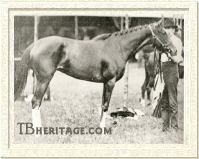
Tanya
| |
That autumn, the Whitney horses came up for sale at Madison Square Garden. Harry Payne Whitney bought several of his father's horses. Whitney purchased TANYA for only $7000. She proved a sound investment, for as a three-year-old in 1905, Tanya captured the Belmont Stakes, run for the first time at brand new Belmont Park. Third in the Belmont was another Meddler offspring, the colt HOT SHOT, a full brother to the aforementioned Trigger. After the Belmont, Tanya ran a game second to champion Sysonby in the Lawrence Realization. Tanya was not as good a broodmare as she had been as a racemare, failing to produce a stakes winner approaching her own class.
|
Crop mate of Tanya was the colt BEDOUIN, out of Lizzie Montrose, by Duke of Montrose. This son of Meddler was a stakes winner each year he raced from age two through age six. His major victories included the colt division of the Matron Stakes, as well as the Jerome, Huron, and Aqueduct Handicaps. He did not sire any recorded foals.
The first several years of the century were triumphant for Meddler as a sire, as he led the American general sire list twice, in 1904 and 1906. In 1904 alone, Tanya, Go Between, and Stalwart each earned in excess of $40,000 -- the first time an American sire had three performers in the same year earn that much in purses.
During the dispersal sale of William Collins Whitney's horses, Clarence MacKay, with Matt Corbett acting as agent, bought Meddler for the sum of $ 51,000. For MacKay, Meddler first stood at Silverbrook Farm in New Jersey, then at Kingston Farm in Kentucky. Despite no longer having access to the best broodmares of the Whitney breeding operation, Meddler still came up with his share of good stakes winners. AFFLICTION, a 1906 filly out of Heartache, by Adieu, was a winner of several stakes, including the Oriental, First Special, Brookdale, Long Island, and Saratoga Handicaps. She produced nothing of high class as a broodmare.
MEDIANT, also foaled in 1906, was a daughter of the Ayrshire mare Ballantrae. She raced for Herman Duryea, and was a winner of the Foam Stakes and Great Eastern Handicap and placed in such events as the Saratoga Special and Junior Champion Stakes. Like many other American Thoroughbreds, she was shipped across the Atlantic after the passing of the Hart-Agnew bill. In England, she took the Stewards' Cup. Sent to Duryea's stud in France, she produced, to the cover of Rabelais, the filly Medora II. Obtained by William Woodward, master of Belair Stud, Medora II was shipped back to the United States, and went on to produce Little Chief, a Wrack colt later campaigned by Rancocas Stable. Little Chief captured the Travers Stakes, Saranac and Manhattan Handicaps at three, and the Brooklyn, Edgemere, and Continental Handicaps at four. Medora II produced five more stakes winners, including Champagne Stakes-winning filly Beatrice, David Bone, Pardee, Silver Lane, and Sir Ashley. A full sister to Mediant was MELODY, foaled in 1909. Raced in England, she notched a second in the Coronation Stakes.
QUICKMATCH, a 1908 colt out of Strike-a-Light, by Donovan, raced in Trinidad, and there went to stud. Serving at the Government Farm in Trinidad, Quickmatch became a leading sire. His best representatives included Take-a-Light, a top older horse in both the West Indies and Venezuela; Busy Maid, a high class performer at three whose career was prematurely ended by suspected foul play; and Footpad, a formidable sprinter.
|
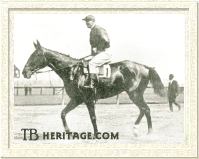
Hylas
| |
HYLAS, foaled in 1901, was bred by William Collins Whitney. He was out of the Exile mare Forget, later renowned as the dam of the durable campaigner Borrow. Hylas made his mark as a steeplechaser. He was first raced by Whitney, and after the latter's death, by Thomas Hitchcock. During his long career, Hylas won events in the United States, France, and Belgium. In America alone, the gelding captured fourteen races from 28 starts, including the Country Club Grand National, the Empire State, and two editions of the Beacon Steeplechase. His best season was 1906, when he defeated the likes of Coligny, Flying Buttress, Candling, Grandpa, and Himmy Lane.
|
It was a sad state of affairs for the breed Meddler failed to leave a son capable of carrying his male line forward. His daughters were another, much more successful, story. YODLER, a foal of 1899 and a daughter of the Tremont mare Yodel, was the dam of the good colt Sweep On. Sired by Sweep, Sweep On was a winner of the Grand Union Hotel Stakes and second to Sir Barton in the Belmont Stakes and third to the same rival in the Preakness Stakes. At stud, Sweep On was not the height of fashion, but got his share of decent runners. His most notable representative was the filly Sweep Out, dam of Outdone, a stakes winner who became dam of Broodmare of the Year Miss Disco and second dam of eight-time leading American sire Bold Ruler.
LEISURE, a daughter of Meddler foaled in 1900, was bred by William Collins Whitney and out of Yorkville Belle, by Miser. Kept by Harry Payne Whitney after his father's death, Leisure produced Royal Tourist, a colt by Sandringham which went on to land the Preakness Stakes in 1908. Whitney bred another winner of the Preakness from Leisure, this one being the Broomstick colt Holiday. The latter was gelded and owned by Mrs. A. Barklie at the time of his Pimlico triumph.
MINEOLA, Meddler's 1901 daughter out of Hurley Burley, by Riley, was a stakes-placed performer. Her best foal was bred by Harry Payne Whitney, the Spearmint colt Johren. Foaled in 1915, Johren was bred in England and brought to the United States as a yearling. He was named for a saloon keeper on Long Island. As a young horse, Johren was one of the most unpromising specimens of the Thoroughbred it was possible to imagine. Walter Vosburgh commented Johren was a "clumsy, loose-jointed, underdeveloped creature." Trainer James Rowe's assessment was even harsher, observing "he can neither gallop, canter, nor walk." When Johren matured, he gave the lie to these criticisms. In 1918, he developed into the nation's champion three-year-old colt, earning victories in the classic Belmont Stakes, Latonia Derby, Huron Handicap, Saratoga Cup (in which he defeated Roamer), and Lawrence Realization. Johren was given every opportunity at stud, but failed to make a success.
PRY, foaled in 1901, out of Eye Sweet by Galopin went to Italy, where she produced Priapo (1918, by Signorino), a winner of the 1921 Gran Premio del Jockey Club.
SLIPPERS, foaled in 1904, was a daughter of the famed mare Cinderella, dam previously of the outstanding performers Hastings and Plaudit. William Collins Whitney had leased Cinderella for a few years, and bred her to Meddler to get Slippers. Upon his death, Slippers was retained by Harry Payne Whitney, and for him produced a colt by Hamburg named Buskin. Gelded and sold to J. Whalen, Buskin went on to capture the Preakness Stakes in 1913.
To the cover of Whitney's Belmont Stakes winner Burgomaster, Slippers produced Polly Flinders, dam of stakes winner Macaw, Coaching Club American Oaks winner Prudish, and the latter's full sister, champion filly Prudery, in turn dam of American classic winners Victorian and Whiskery.
WALLFLOWER, out of Kamara, by Candlemas, was born in 1906. She spent part of her broodmare career in France before being brought back to the states. Through her daughter Memories, by Rabelais, Wallflower became third dam of Belmont Stakes winner Peace Chance.
MISS MINNIE, out of imported Spectrum, by Orvieto, was foaled in 1908. On the racecourse, Miss Minnie started ten times at two and three, and managed only a third place for her best effort. As a broodmare at John Madden's Hamburg Place, she produced only three foals, two of which failed to win. The third was a blaze-faced chestnut colt by Madden's leading sire Star Shoot. This colt was sold as a yearling in 1919 to trainer Max Hirsch and sold again to trainer Sam Hildreth for the stable of oilman Harry F. Sinclair. He was named Grey Lag, after the European wild goose northern Britons called "grey lags," and became famed as one of the very best horses produced from a Meddler mare. Racing for Sinclair's Rancocas Stable, the chestnut son of Star Shoot--Miss Minnie became America's champion three-year-old colt and Horse of the Year in 1921 and a top handicap performer the next two seasons. Grey Lag's victories during this three year skein included the Brooklyn Handicap (over Mad Hatter, Exterminator, John P. Grier, and Paul Jones), the Dwyer Stakes, Queens County Handicap, and the Excelsior, Metropolitan, and Suburban Handicaps.
Grey Lag proved virtually useless as a stud, getting only nineteen foals. Eventually, Grey Lag was given away to a vet for use as a riding horse, and after the gentleman's death, the old champion changed hands several times, in each instance sinking lower down. At last, as a 13-year-old, Grey Lag was found competing in cheap claiming races at some of Canada's most modest racing facilities. Harry Sinclair once again came into the horse's life, unobtrusively re-acquiring his old champion and allowing him to live out his days as a pensioner at Rancocas, which he did until his death in 1942.
Even though Grey Lag failed as a progenitor, he did have a half-sister, Minima, by Friar Rock, which proved a fine producer. Minima was the dam of three stakes winners and ancestress of champion filly Track Robbery, European champion Hernando, and major winners Labeeb, Cat Thief, and Palace Music.
Meddler's union with Correction, a full sister to Domino, produced the filly MISS MALAPROP in 1909. This daughter of Meddler became the dam of the speedy colt Haste, by Maintenant. Haste was a top notch two-year-old, taking such important events as the Grand Union Hotel Stakes and Saratoga Special. At three, Haste won the Withers and managed a game third Crusader in the 1926 Belmont Stakes. Haste was a good stallion, becoming the sire of Belmont Stakes winner Hurryoff and broodmare sire of American Triple Crown champion Count Fleet.
A full sister to Miss Malaprop was NATURE, foaled in 1906. Nature was exported to France, where she enjoyed a successful career as a broodmare. Her son Naturalist, an evil-tempered gelding by Rabelais, was brought back to the states where he won several stakes, including two runnings of the Manhattan Handicap. Naturalist's full sister, Carnation, remained in France and won stakes. A half-brother to Naturalist and Carnation was the Spearmint colt Chiclet. Like Naturalist, Chiclet was brought to the states and won the Edgemere Handicap and a race in the Pimlico Fall Serial weight-for-age series. Nature's family bred on, for she became ancestress of champion Royal Native, Kentucky Derby winner Lil E. Tee, Triple Crown winner Affirmed, and champion Ghostzapper.
Meddler's daughter CAFE AU LAIT, foaled in 1910, was produced from the Hastings mare Gunfire. Cafe au Lait made no name for herself on the racetrack. As a broodmare, she produced two stakes winners: Flash and Miller Stakes winner Stirrup Cup and Untidy. A filly by Wrack, Untidy became America's champion three-year-old filly in 1923. She was victorious in the Kentucky Oaks, Alabama Stakes and Gazelle Stakes, and placed in the Lawrence Realization, Pimlico Oaks, Manhattan Handicap, and Coaching Club American Oaks.
In 1909, Clarence MacKay moved his entire stud operation to France, Meddler included. In France, Meddler was not as successful as he had been in America, but during his tenure in France, he did sire two important fillies, CREPUSCULE and BALANCOIRE II. Crepuscule, foaled in 1914, was a full sister to Quickmatch. Crepuscule was a useful racefilly, winning six times. She was purchased by George D. Widener and shipped across the Atlantic to Kentucky. Crepuscule's foal of 1929, the St. James filly Evening, was a tough filly, defeating males in the Florida Derby and Chesapeake Stakes. Crepuscule's daughter by Man o' War was Armada, a non-winner who fared better as a broodmare, becoming the dam of Coaching Club American Oaks victress High Fleet and second dam of multiple stakes winner Sailor. Crepuscule's union with Stefan the Great yielded the winning filly Stefana, who in turn became the dam of 1943 champion three-year-old filly Stefanita.
|
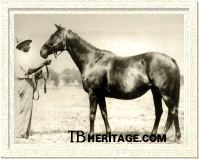
Balancoire
| |
BALANCOIRE II was a full sister to Mediant. Balancoire II was a stakes winner in France. Following her career on the track, she was acquired by American interests and shipped to Kentucky. Balancoire II bred six winners, including stakes winner Distraction and stakes-placed Swinging. The latter never won a stakes, but was a tough, high-class filly. At the age of two in 1924, she defeated four-year-old Zev in an all-aged race. She passed on her talent as the dam of Equipoise. Her elder half-sister, Balance, by Rabelais, was unraced, but assured her name in turf history as the second dam of Seabiscuit and fourth dam of Kentucky Derby winner Determine.
|
Meddler died at the age of 26 at Fresnay Stud in Normandy on April 17, 1916. His owner, Clarence MacKay, outlived him. Meddler's male line, and that of his sire, St. Gatien, have long been dead. But through his daughters, the genes of Meddler passed on to some of the most recognized Thoroughbreds of the twentieth century.
--Liz Martiniak
|
|
|
|

